AUTHOR: Emery, Irene
TITLE: The primary structures of fabrics : an illustrated
classification / by Irene Emery.
PUBL.: New York : Watson-Guptill Publications/Whitney Library of
Design,
FORMAT: xxvi, 341 p. : ill. ; 31 cm.
DATE: 1995
SUBJECT: Textile fabrics--Classification.
ISBN: 0823043940 :
LANGUAGE: ENGLISH
CONTENTS: Includes bibliographical references (p. 259-308) and index.
RID #: ocm30437380
In the majority [of fabrics], separate “elements” (each with its own
structural makeup) are systematically interworked to form a coherent
material. The particular nature and order of the interworking (the pattern
or grouping of elements) is what distinguishes one such fabric from
another, and consequently classification of the structures rests on
classification of the systems of interworking. For this it is necessary,
first, to determine the number of elements or sets of elements on which
each system is based.
ELEMENT – a component part or unit of the structure of an interworked
fabric. The term refers to yarn, thread, strand, cord, thong, or whatever
natural or contrived unit of fibers or filaments is interworked to form a
fabric.
SET OF ELEMENTS – a group of such components all used in a like manner,
that is, functionally undifferentiated and trending in the same direction.
Whenever certain elements are differentiated from others in the same
fabric, either in the direction they take, or by the purpose they serve in
the structure, they constitute a separate set of elements.
Classified on the basis of the number of elements or sets of elements that
are interworked, fabric structures fall into four main categories:
single-element structures,
two-single-element structures,
one-set-of-element structures,
two-or-more-sets-of-element structures.
A single-element structure is made up of a single continuous element
interworked with itself….
A two-single-element structure is made up of two functionally distinct
elements, the passages of one interworked and secured by the stitches of
the other….
In one-set-of-element structures a minimum of three functionally
undifferentiated elements have a common directional trend and are
interworked with each other.
In two-or-more-sets-of-element structures there is a basic minimum of two
sets (warp and weft) which differ from each other in the direction they
take in the fabric. The last named category is large and immensely
varied…
A. Single Element
A fabric structure can be built up by the repeated interworking of a
single continuous element with itself. The structure is based on the
formation of rows (or courses) of “stitches” of varying types and degrees
of complexity, into which successive rows are worked. It is classified
according to the type of connection that the element makes with the
previous row…
It is possible to develop any of the single element fabric structures in
either of two ways:
spirally to form cone-shaped, tube-shaped, or flat circular fabrics; or
back and forth in the same plane to produce square, rectangular or
otherwise shaped fabrics.
1. Linking (presented for background and comparison MB)
In “simple linking” (fig 7) successive rows of running “open loops”
are formed by a stitch like that known in sewing as overcasting or
whipping. Each row is formed by a progressive spiraling of the element
round the portions between the stitches of the previous row. The meshes
tend to be elongated and the openings may be barely perceptible unless the
fabric is spread (as in figures 7 and 8) or the element is stiff enough to
retain the openings. The two faces [front and back sides] are identical.

figure 7. Simple linking.
The link is made firmer by the addition of a twist, that is, by taking
a complete turn (two overcasting stitches or a “round turn”) round the
element in the previous row (figure 8)….
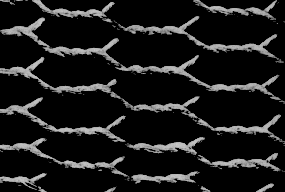
figure 8. Link and twist (or twisted linking). (The twist shown here
occurs when you give the bubbles an extra twist or two while connecting
them. This extra wrap of latex is hidden down between the bubbles. MB)
in linked fabrics are identical with those developed vertically by means of
a set of elements in interlinking. Unless ends and edges of the fabric are
intact, it may be impossible to determine the process of construction from
the evidence of the specimen.
B. Two Single Elements
Fabric structures composed of two single but differentiated elements are
closely related to those of only one. The two-element structures are
effected by interworking the linking or looping stitches of a single
element with a second or “foundation” element. The element which forms the
stitches is the active or sewing element. The other one is used
concurrently as a relatively passive foundation or support, round or
through which the stitches are formed by the sewing element.
Although the two elements are clearly differentiated in function, they
may or may not differ in quality or in kind…. In laces and many
net-like fabrics the same thread or cord is used for both the sewing and
foundation, but an identical fabric structure may be found (in a basket for
example) in which the sewing element is relatively fine and flexible while
the foundation element is a large and somewhat rigid unit often of complex
make-up. Such qualitative differences in the elements are important items
for descriptive analysis but should not be allowed to affect the
identification of the structural type.
Classification of two-single-element structures is based primarily on
the structure of the stitch, secondarily on the way it is used….
Two-single-element structures, like the single-element ones from which they
derive, can be developed either back and forth in the same plane, or round
and round to form flat spiral, cone, or tube shapes.
Note on the classification of a related structure:
Wrapping one element round another is one of the most elementary methods
of fastening separate units together or adding unit to unit in the
construction of fabrics. Linking (see previous explanation and figure) is
primarily a fastening of one passage of a single element to another by
repeatedly and at regular intervals “wrapping,” or winding, it part or all
the way round the previous passage.
In linking on a foundation (figure 57) successive passages of one
element are secured by being wrapped in a similar running-spiral fashion by
a second element. In both these structures, the general directional trend
of the wrapping element is the same as that of the element it repeatedly
wraps.

figure 57. Simple linking on a foundation element (interlocked stitches)
crosses and encircles each of a series of elements running at more or less
right angles to it. Wrapping of this sort (the Hardy method used for
sunbursts/lanterns MB) can be described as progressive. It is extensively
used, and with such freedom and diversity of application that it is
exceptionally difficult to classify. References to it should identify both
the essential structure (wrapping) and its particular application…. Each
particular example of the use of wrapping can be individually classified
according to its particular combination of elements or sets of elements –
as two single elements, two sets of elements, a single element on a
foundation set, a set of elements wrapping a single foundation element, and
so on. (THE HARDY/MOSS METHOD IS A TWO-SINGLE-ELEMENT STRUCTURE,
COMPRISED OF A SINGLE “ACTIVE” OR “SEWING” ELEMENT PROGRESSIVELY WRAPPING A
SINGLE “PASSIVE” FOUNDATION ELEMENT. MB)
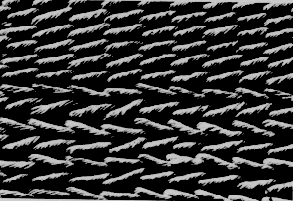
countered (below). (The wrapping shown here occurs when you twist the
bubbles together to connect them. This wrap of latex is hidden down
between the bubbles. MB)
C. One Set of Elements
Classification rests on the four essentially different ways in which the
undifferentiated elements of a single set can be interworked:
1. Interlinking (or plaiting), which is interworking by means of the
simple connection between parts that is termed linking in single-element
structures, and called interlinking when it is used in the multiple action
of interconnecting the elements of a single set.
2. Oblique interlacing (or braiding) which is a flat, over-and-under
interworking, the nature of which is frequently the same as that of
interwoven warp and weft elements, but which is clearly distinguished (if
there is an edge intact) by the oblique crossings of the elements and their
common directional trend.
3. Oblique twinning in which pairs of elements, twining about each other,
enclose elements on the opposite diagonal course.
4. Interknotting (or macrame’)…
A single set of undifferentiated elements, particularly with free-hanging
ends, offers almost unequaled opportunity for varying the manipulation of
the elements at will and for combining different types of structure in a
single fabric. Although the one-set-of-element structures are especially
appropriate for narrow fabrics, very few of them are restricted to that
use.
1. Interlinking (plaiting)
The terms “interlinking” and “plaiting” are not always considered
equivalent because plaiting is not only used but defined in quite
contradictory ways…. many definitions relate plaiting to braiding,
although agreement on the relationship is lacking… Plaiting is also
defined as synonymous with weaving “when all weaving elements are of like
quality.” Since this presumably refers to “finger-weaving” or “weaving
without a loom,” it is a method of handling elements that is being called
plaiting, not a fabric structure.
It seems that before the term plaiting can be used effectively its
meaning will have to be clarified and its connotations differentiated from
those of braiding and weaving. For example, by limiting the term plaiting
to one-set-of-element structures in which the elements interlink with
adjacent ones (figures 66-71), and the term braiding to those one-set
structures in which the elements interlace with each other obliquely
(figures 72-77), both terms would be given more precise meaning and the
term “weaving” could be used without ambiguity to denote warp-weft
interlacing of two-or-more-sets-of-elements.
Interlinking is the structure produced by the link type of connection
between undifferentiated elements of a single set. ***Elements
consistently link with adjacent or nearly adjacent ones on either side, and
change their relative positions only slightly throughout the fabric. In
the simplest form of interlinking (figure 66), each element zig-zags back
and forth, linking alternately with one to the right and one to the
left.***

figure 66. Interlinking or plaiting (crossing right over left)
One widely used variation of interlinking is effected by the addition
of one or more twists to the link (figure 70). It is used at times for
entire fabrics, at times in conjunction with plain interlinking for
openwork effects and textural variety.
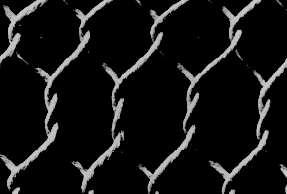
twist shown here occurs when you give the bubbles an extra twist or two
while connecting them. This extra wrap of latex is hidden down between the
bubbles. MB)
Another common device for creating open spaces is the omission of certain
links in the regular order of interlinking (figure 71). These and other
variations are sometimes combined to produce intricate and beautiful
patterning in structurally simple fabrics.
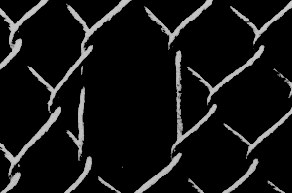
figure 71. Open space created by the omission of one link in the regular
order of interlinking.
Interlacing…, this over and under crossing of elements will produce
the coherence necessary for a fabric without fastening one element to
another by any sort of linking, looping, wrapping or knotting. When
undifferentiated elements with a common starting point are interlaced, the
course of the elements is oblique to the edges of the fabric and the
structure differs from that of interlinking not only in the nature of the
interworking but in the fact that changes in direction usually occur only
at the edges of the fabric where the elements turn back on the opposite
diagonal (figure 73).
The general principles of oblique interlacing are exemplified in its
simplest manifestation, the three strand braid…
Oblique interlacing and weaving are both forms of interlacing, and
whenever the order of interlacing is the same in both, the same term is
likely to be used to designate it. Nevertheless, the structural types are
different and the distinction should be evident in the designation. The
common starting point and directional trend of the elements – elements that
are oblique to the edges of the fabric and do not necessarily cross each
other at right angles – distinguish oblique interlacing from weaving
proper, even when the order of the interlacing is the same.
Figure 72 shows a plain oblique interlacing entirely comparable to a
plain-weave textile except for the oblique trend of all the elements
without differentiation. Figure 73 shows the turn of the elements at the
edges of the fabric.

figure 72. Plain oblique interlacing, or plain braiding.
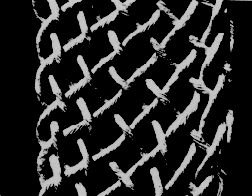
change of direction at the edges.
3. Oblique twining
In descriptions of fabric structure, the term twine is so commonly
used to denote a turning of two or more elements about each other so as to
enclose other elements, that it should be restricted to that use. The term
twist will then distinguish a simple turning of two or more elements about
each other without enclosing others.
To twist: to combine two or more elements by winding together
To twine: to enclose one or more elements in the twisting of
two or more others.
Single
In oblique twining, pairs of elements moving on an oblique course
enclose elements moving on the opposite diagonal as they twine about each
other. The elements may be proceeding singly or in pairs, but in either
case, the oblique twining is said to be single if, in a given area, the
twining elements all move on one diagonal while the elements on the
opposite diagonal are all passively enclosed. In single oblique twining,
then, all elements necessarily change their roles when they turn at the
edge of the fabric to proceed on the opposite diagonal. (figure 78)
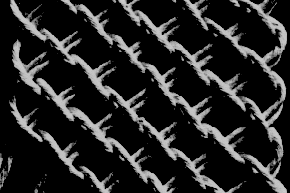
figure 78. Diagrammatic construction of single oblique twining, (twining on
only one diagonal at a time).
Oblique twining can be described as double when the elements
consistently function in pairs and twine continuously on both diagonals
(figure 79). There is no “change of roles”…
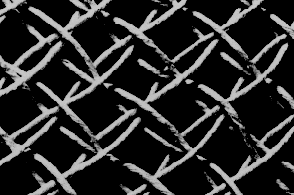
figure 79. Diagrammatic construction of double oblique twining, (twining on
both diagonals) when one twining pair encloses another.
Interlinking – Plaiting
The ambiguity of the term plaiting was discussed briefly, and a clearer
distinction between the meanings of plaiting, braiding and weaving was
suggested as a way of making it possible to use plaiting for precise
designation of the type of interworking known as interlinking. At present,
the term plaiting is so commonly used for general reference to any
interworking of elements accomplished without mechanical aids, and has, in
addition, so many less general but extremely variant uses, that it conveys
no exact concept.
A rapid survey of some 50 definitions and explanations of the term
reveals that the most common distinction made between plaiting and other
interworking is based on the premise that plaiting is constructed with a
single set of undifferentiated elements. This distinction is more-or-less
ambiguously expressed in a variety of ways: “the elements are all active and
passive at different times,” “no elements are passive,” … On the other
hand, plaiting is quite often explained as the “basketry equivalent of
weaving” and the term weaving implies at least two sets of elements
differentiated in direction if not necessarily in quality.
Differentiation between plaiting and weaving is variously said to be
based on the nature (quality) of the elements, on the absence of a loom, on
the oblique rather than parallel relationship of “both sets of elements” to
the edges of the fabric, or on the use of only “one group of elements” as
opposed to the “two groups” used in weaving…. [various uses of
“plaiting” mentioned] In many of these terms, plaiting may only be meant
to imply the absence of a loom or any use of implements.
These few examples of the diversity with which the term plaiting is
defined and used are enough, perhaps, to demonstrate the importance of
greater restraint in appropriating the term for special uses, and the real
necessity of making the exact meaning clear whenever it is used. For
precise designation of structure, the term interlinking is less subject to
misinterpretation than plaiting, and… has the virtue of being reasonably
explicit. With either term, clear representation of the structures
referred to should accompany description of particular examples.
Braiding – Braids – Oblique Interlacing
The term braiding is obviously subject to some of the same confusion of
interpretation as plaiting. The two terms are, in fact, peculiarly
intermixed in use, although braiding is less apt to be used as a
designation of interworking without the use of implements, and is more
consistently associated with one-set-of-element constructions….
If all specific association with narrow bands and cords is restricted
to the word braid, braiding can be used to designate both the process and
structure of all oblique interlacing, But until and unless the term
braiding is clearly associated with interlacing of a single set of elements
as contrasted with other forms of interworking, “oblique interlacing” seems
to be the only explicit term for the structure.